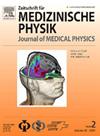超极化 13C 核磁共振成像的现状如何?
IF 4.2
4区 医学
Q2 RADIOLOGY, NUCLEAR MEDICINE & MEDICAL IMAGING
引用次数: 0
摘要
在过去的二十年里,超极化 13C MRI 在临床前和临床研究中都获得了重要的地位,这依赖于 PHIP-SAH(副氢诱导极化-侧臂氢化)、SABRE(可逆交换信号放大)和 dDNP(溶解动态核极化)等技术,其中 dDNP 已应用于人体。尽管存在成本高、极化速度慢等挑战,但临床 dDNP 极化器已在 24 个地点开展了研究。SABRE 和 PHIP 等基于对氢的技术提供了更快、更具成本效益的替代方法,但需要针对特定分子进行优化。重点一直放在超极化探针的成像代谢上,这需要长 T1、高极化和快速生成对比度。目前正在努力建立新型探针、改进采集技术和增强数据分析方法(包括人工智能)。超极化 13C 磁共振成像的潜在临床价值主要体现在肿瘤学的治疗反应评估上,同时也体现在心脏病学、肾脏病学、肝脏病学和中枢神经系统特征描述上。在这篇关于生物医学超极化 13C MRI 的综述中,我们总结了极化技术、探针开发、采集和分析方法以及临床试验方面的重要最新进展。从这些进展出发,我们试图勾勒出生物医学超极化 13C MRI 领域的发展轨迹。本文章由计算机程序翻译,如有差异,请以英文原文为准。
Quo Vadis Hyperpolarized 13C MRI?
Over the last two decades, hyperpolarized 13C MRI has gained significance in both preclinical and clinical studies, hereby relying on technologies like PHIP-SAH (ParaHydrogen-Induced Polarization-Side Arm Hydrogenation), SABRE (Signal Amplification by Reversible Exchange), and dDNP (dissolution Dynamic Nuclear Polarization), with dDNP being applied in humans. A clinical dDNP polarizer has enabled studies across 24 sites, despite challenges like high cost and slow polarization. Parahydrogen-based techniques like SABRE and PHIP offer faster, more cost-efficient alternatives but require molecule-specific optimization. The focus has been on imaging metabolism of hyperpolarized probes, which requires long T1, high polarization and rapid contrast generation. Efforts to establish novel probes, improve acquisition techniques and enhance data analysis methods including artificial intelligence are ongoing. Potential clinical value of hyperpolarized 13C MRI was demonstrated primarily for treatment response assessment in oncology, but also in cardiology, nephrology, hepatology and CNS characterization. In this review on biomedical hyperpolarized 13C MRI, we summarize important and recent advances in polarization techniques, probe development, acquisition and analysis methods as well as clinical trials. Starting from those we try to sketch a trajectory where the field of biomedical hyperpolarized 13C MRI might go.
求助全文
通过发布文献求助,成功后即可免费获取论文全文。
去求助
来源期刊
CiteScore
3.70
自引率
10.00%
发文量
69
审稿时长
65 days
期刊介绍:
Zeitschrift fur Medizinische Physik (Journal of Medical Physics) is an official organ of the German and Austrian Society of Medical Physic and the Swiss Society of Radiobiology and Medical Physics.The Journal is a platform for basic research and practical applications of physical procedures in medical diagnostics and therapy. The articles are reviewed following international standards of peer reviewing.
Focuses of the articles are:
-Biophysical methods in radiation therapy and nuclear medicine
-Dosimetry and radiation protection
-Radiological diagnostics and quality assurance
-Modern imaging techniques, such as computed tomography, magnetic resonance imaging, positron emission tomography
-Ultrasonography diagnostics, application of laser and UV rays
-Electronic processing of biosignals
-Artificial intelligence and machine learning in medical physics
In the Journal, the latest scientific insights find their expression in the form of original articles, reviews, technical communications, and information for the clinical practice.

 求助内容:
求助内容: 应助结果提醒方式:
应助结果提醒方式:


